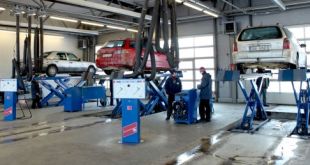Analytics, Corruption, Financial Services, Latvia, Legislation, Transport
International Internet Magazine. Baltic States news & analytics
Thursday, 25.04.2024, 12:53
Latvia: Management of corruption risks in the Road Traffic Safety Directorate
 Print version
Print version |
|---|
The state-owned company “Road Traffic Safety Directorate” (RTSD) carries out the registration and technical supervision of road vehicles, testing of qualification of drivers and issuance of driving licences and provides other services.Between 2004 and 2012, three officials of the RTSD were convicted for corruption. Meanwhile surveys show low presence of corruption in the provision of services of the RTSD. In 2012, out of the respondents who had used the services (registration or technical inspection of vehicles), 92.7% answered that they did not use any private relationships, gifts or unofficial payments. Only 0.8% admitted giving a gift or paying unofficially LVL 5 (approx. EUR 7.11) or more.
The RTSD has adopted an elaborate Corruption Prevention Programme with detailed addenda for specific areas of work – the technical control of vehicles, qualification of drivers, registration of vehicles, the economic activity (procurement, etc.), public relations, cash transactions, and information technologies. The system uses the concept of warning signs. For the area of the technical inspection of vehicles, unrealistically short time between the primary and repeated inspections (when it is apparently insufficient for correcting of the deficiencies found in the primary inspection) or situations when the same individual has the inspection carried out by the same inspector repeatedly are examples of such warning signs. According to the Programme the warning signs shall be detected by analysing the database of technical inspections. The analysis of video recordings shall be used to verify that vehicles entered in the inspections database were in reality subject to the inspection. Repeated inspections of random or specifically selected vehicles are used in order to detect omissions in the primary inspection.
Particular control measures are undertaken based on a wide range of information such as informal communication from employees of the RTSD, signs of unusual activity identified through the analysis of databases of the RTSD, and even discussions of drivers in online forums or advertisements where private persons promise success in settling particular kinds of matters in the RTSD in return for money. A procedure for action is approved for situations when an employee has been offered a bribe.
Sources: Author’s interview with Ivars Rullers, Head of Anticorruption Department of the RTSD, 16 December 2013; Ceļu satiksmes drošības direkcija (2005), Par korupcijas novēršanas programmu. Rīkojums, 06/12/05; Ceļu satiksmes drošības direkcija (2005), CSDD korupcijas novēršanas programmas 1. pielikums CSDD pretkorupcijas programmas pasākumi transportlīdzekļu tehniskās kontroles jomā; Corruption °C (2013), Trial Statistics for Offences Committed in Public Service in Latvia 2004 – 2012. Centre for Public Policy PROVIDUS. http://corruption-c.wikidot.com/statistics-on- trials-of-corruption-cases; Latvijas fakti un Korupcijas novēršanas un apkarošanas birojs (2012), Attieksme pret korupciju Latvijā; http://www.knab.lv/uploads/free/attieksme_pret_korupciju_2012.pdf
Full text “Prevention of Corruption in the Public Sector in Eastern Europe and Central Asia”, OECD-2015:
http://providus.lv/article_files/3002/original/ACN-Prevention-Corruption-Report.pdf?1433752298








 «The Baltic Course» Is Sold and Stays in Business!
«The Baltic Course» Is Sold and Stays in Business!

